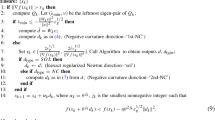Abstract
We estimate d-dimensional least squares approximations of an arbitrary d-regular measure μ via discrete curvatures of d+2 variables. The main result bounds the least squares error of approximating μ (or its restrictions to balls) with a d-plane by an average of the discrete Menger-type curvature over a restricted set of simplices. Its proof is constructive and even suggests an algorithm for an approximate least squares d-plane. A consequent result bounds a multiscale error term (used for quantifying the approximation of μ with a sufficiently regular surface) by an integral of the discrete Menger-type curvature over all simplices. The preceding paper (part I) provided the opposite inequalities of these two results. This paper also demonstrates the use of a few other discrete curvatures which are different from the Menger-type curvature. Furthermore, it shows that a curvature suggested by Léger (Ann. Math. 149(3), pp. 831–869, 1999) does not fit within our framework.
Similar content being viewed by others
References
Chen, G., Lerman, G.: Foundations of a multi-way spectral clustering framework for hybrid linear modeling. Found. Comput. Math. 9(5), 517–558 (2009)
Chen, G., Lerman, G.: Spectral curvature clustering (SCC). Int. J. Comput. Vis. 81(3), 317–330 (2009)
David, G.: Wavelets and Singular Integrals on Curves and Surfaces. Lecture Notes in Mathematics, vol. 1465. Springer, Berlin (1991)
David, G., Semmes, S.: Singular integrals and rectifiable sets in ℝn: au-delà des graphes Lipschitziens. Astérisque 193, 1–145 (1991)
David, G., Semmes, S.: Analysis of and on Uniformly Rectifiable Sets. Mathematics Surveys and Monographs, vol. 38. American Mathematical Society, Providence (1993)
Farag, H.M.: The Riesz kernels do not give rise to higher-dimensional analogues of the Menger–Melnikov curvature. Publ. Mat. 43(1), 251–260 (1999)
Guillet, J.M., Lerman, G.: Numerical search for high-dimensional Menger–Riesz-type curvatures (in preparation)
Hahlomaa, I.: Menger curvature and Lipschitz parametrizations in metric spaces. Fund. Math. 185(2), 143–169 (2005)
Hahlomaa, I.: Curvature integral and Lipschitz parametrization in 1-regular metric spaces. Ann. Acad. Sci. Fenn. Math. 32(1), 99–123 (2007)
Jones, P.W.: Rectifiable sets and the traveling salesman problem. Invent. Math. 102(1), 1–15 (1990)
Léger, J.C.: Menger curvature and rectifiability. Ann. Math. (2) 149(3), 831–869 (1999)
Lerman, G.: Quantifying curvelike structures of measures by using L 2 Jones quantities. Commun. Pure Appl. Math. 56(9), 1294–1365 (2003)
Lerman, G., Whitehouse, J.T.: High-dimensional Menger-type curvatures—part I: Geometric multipoles and multiscale inequalities (submitted). See also http://front.math.ucdavis.edu/0805.1425
Lerman, G., Whitehouse, J.T.: Least square approximations for probability distributions via multi-way curvatures (in preparation)
Lerman, G., Whitehouse, J.T.: On d-dimensional d-semimetrics and simplex-type inequalities for high-dimensional sine functions. J. Approx. Theory 156, 52–81 (2009)
Lerman, G., McQuown, J., Blais, A., Dynlacht, B.D., Chen, G., Mishra, B.: Functional genomics via multiscale analysis: application to gene expression and chip-on-chip data. Bioinformatics 23(3), 314–320 (2006)
Lerman, G., McQuown, J., Mishra, B.: Multiscale robust regression and multiscale influence analysis (2009, submitted)
Mattila, P., Melnikov, M., Verdera, J.: The Cauchy integral, analytic capacity, and uniform rectifiability. Ann. Math. (2) 144(1), 127–136 (1996)
Menger, K.: Untersuchungen über allgemeine Metrik. Math. Ann. 103(1), 466–501 (1930)
Schul, R.: Ahlfors-regular curves in metric spaces. Ann. Acad. Sci. Fenn. Math. 32, 437–460 (2007)
Schul, R.: Bi-Lipschitz decomposition of Lipschitz functions into a metric space. Rev. Mat. Iberoam. 25(2), 521–531 (2009)
Schul, R.: Big-pieces-of-Lipschitz-images implies a sufficient Carleson estimate in a metric space. arXiv:0706.2517 (2007)
Semmes, S.: Bilipschitz embeddings of metric spaces into Euclidean spaces. Publ. Mat. 43(2), 571–653 (1999)
Tolsa, X.: Principal values for Riesz transforms and rectifiability. J. Funct. Anal. 254(7), 1811–1863 (2008)
Väisälä, J.: Gromov hyperbolic spaces. Expo. Math. 23(3), 187–231 (2005)
Author information
Authors and Affiliations
Corresponding author
Additional information
Communicated by Mauro Maggioni.
This work has been supported by NSF grant #0612608
Rights and permissions
About this article
Cite this article
Lerman, G., Whitehouse, J.T. High-Dimensional Menger-Type Curvatures—Part II: d-Separation and a Menagerie of Curvatures. Constr Approx 30, 325–360 (2009). https://doi.org/10.1007/s00365-009-9073-z
Received:
Revised:
Accepted:
Published:
Issue Date:
DOI: https://doi.org/10.1007/s00365-009-9073-z
Keywords
- Least squares d-planes
- Multiscale geometry
- Ahlfors regular measure
- Uniform rectifiability
- Polar sine
- Menger-type curvature




